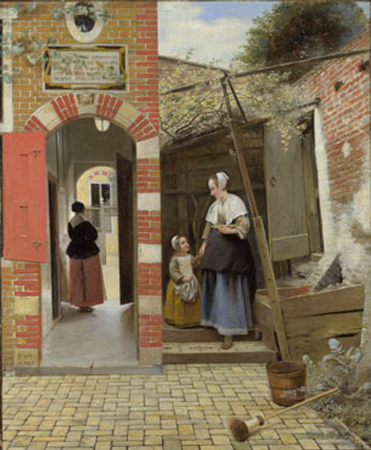RUSKIN had a low opinion of Dutch art: ''The patient devotion of besotted lives to delineation of bricks and fogs, cattle and ditchwater.'' ''Brief Encounters: Vermeer and de Hooch'', the latest in the National Gallery's series of displays bringing together a pair of closely related paintings, proves him right at least about the patient devotion and the bricks. Pieter de Hooch's The Courtyard of a House in Delft of 1658 and Jan Vermeer's Street in Delft of 1658- 60 each feature lots of bricks, very patiently painted. But they also show that paintings of ordinary things need not be ordinary.
A characteristic twentieth-century response to de Hooch's painstaking recreation of the courtyard at the back of a house in Delft might run along the lines of: so what? De Hooch's apparent straightforwardness is apt to look, to modern eyes, suspiciously like banality. What a dull and uneventful scene, after all, the artist has painted: outside, within the small confines of a brick courtyard, a maidservant leads a smiling little girl by the hand; in the hallway of the main house, open both to the courtyard and to the street, another woman stands, with her back to the viewer, looking away. Nothing much, maybe - yet de Hooch's painting of an ordinary scene in an ordinary home contains its own small drama and is imbued, throughout, with a subtly domesticated form of symbolism.
The Courtyard of a House in Delft is a testament to the Dutch seventeenth-century preoccupation with the home as both seat of private virtue and microcosm of the well-run commonwealth. The painting stands at the opposite pole from those other, livelier scenes of drunkenness and affray also common in Dutch art of the time: an image not of the tavern, with its sensual and moral temptations,...

A bricklayer's view of the world
28-07-1992

